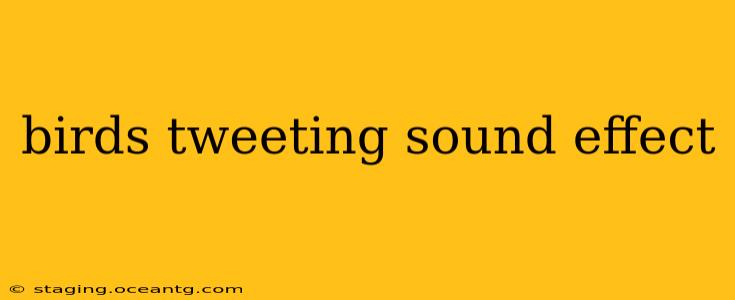The cheerful chirping of birds is a ubiquitous sound effect, instantly conjuring images of spring mornings, sun-drenched meadows, and peaceful tranquility. But the seemingly simple "birds tweeting sound effect" encompasses a vast variety of sounds, depending on the species, time of day, and even the bird's mood. Understanding these nuances can help you choose the perfect audio for your project, whether it's a film, game, or simply setting the ambiance in your home.
What are the Different Types of Bird Sounds Used as Sound Effects?
This isn't a simple question! The term "birds tweeting" is quite broad. Different birds produce wildly different sounds. Some common bird sounds used as sound effects include:
- Chirping: This is the most common type, often associated with smaller birds and characterized by short, high-pitched, repetitive sounds.
- Singing: This typically involves longer, more melodic sequences, often associated with males attracting mates. Different bird species have incredibly distinct songs.
- Calling: Shorter, sharper sounds used for communication, often for warnings or territorial claims.
- Warbling: A complex, flowing series of notes, creating a bubbling or trilling effect.
- Squawking: Louder, harsher sounds, often associated with larger birds.
The exact sound effect you choose will depend entirely on the mood and context you're aiming to create.
Where Can I Find High-Quality Bird Tweeting Sound Effects?
Numerous resources offer high-quality bird sounds:
- Sound effect libraries: Websites such as freesound.org (often require attribution) and Epidemic Sound (subscription-based) offer extensive collections. Many stock music sites also include sound effects. Search specifically for "bird sounds," "bird song," or "bird calls" to find appropriate options.
- Creative Commons resources: Look for Creative Commons licensed sound effects on sites like YouTube Audio Library; remember to always check the license before use to understand any attribution requirements.
- Field recording: If you have the equipment and skill, recording your own bird sounds can be incredibly rewarding and provide highly unique audio.
How Do I Choose the Right Bird Sound Effect for My Project?
Selecting the perfect bird tweeting sound effect requires careful consideration:
- Mood: Do you want a cheerful, peaceful, or slightly ominous atmosphere? A chirping sparrow creates a different feel than the cry of a hawk.
- Context: The setting influences the sound choice. A rainforest scene would call for different sounds than a suburban garden.
- Volume and placement: Adjust the volume and placement of the sound effect to ensure it fits naturally within your project's audio landscape. Avoid overwhelming other sounds.
- Authenticity: Consider the geographic location and time of year. Using a tropical bird call in a setting in the arctic might sound jarringly out of place.
Are There Free Bird Sound Effects Available?
Yes, many free resources exist, but be mindful of the licensing terms. Some might require attribution, while others might only permit non-commercial use. Always double-check the license before incorporating the sound into your work. Free options are often good starting points, but for professional projects, higher-quality, royalty-free options might be worthwhile.
What Software Can I Use to Edit Bird Sound Effects?
Many audio editing software programs can be used to adjust bird sounds. Popular options include Audacity (free and open-source), GarageBand (Mac), and Adobe Audition (subscription-based). These programs allow you to adjust volume, pitch, and add effects to better integrate the sounds into your project.
How Can I Make Bird Sounds Louder or Softer?
Most audio editing software provides volume controls allowing you to adjust the loudness of your bird sound effect. Simple volume faders are generally readily available, providing fine-grained control over the sound's intensity.
By carefully considering the type of bird sound, its source, and its integration into your project, you can effectively use bird tweeting sound effects to enhance your creative endeavors and add a touch of nature to your work.
